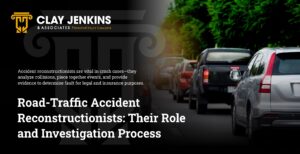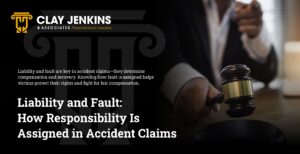
Road-traffic accident reconstructionists play a crucial role in analyzing vehicular collisions and determining the sequence of events leading to crashes. Road-traffic incidents require thorough investigation to establish facts, assign responsibility, and provide evidence for legal proceedings and insurance claims.
What Is A Road-Traffic Accident Reconstructionist?
A road-traffic accident reconstructionist serves as a trained professional who scientifically analyzes vehicular crashes to determine how accidents occurred. These professionals combine engineering principles, physics, and forensic techniques to piece together the events surrounding motor vehicle collisions, providing objective analysis that proves invaluable in legal disputes and insurance investigations.
For a free legal consultation, call (972) 938-1234
How Do Reconstructionists Investigate Accidents?
Reconstructionists investigate accidents through systematic methodologies that examine physical evidence, witness accounts, and environmental factors. The investigation process involves multiple phases of data collection and analysis to build a comprehensive understanding of the collision dynamics.
Examining The Accident Scene
Examining the accident scene forms the foundation of reconstruction work, where professionals document road conditions, traffic patterns, and environmental factors present during the collision. Scene examination must occur promptly to preserve critical evidence before weather or traffic alters the physical indicators.
Documenting Skid Marks
Documenting skid marks provides essential information about vehicle speed, braking patterns, and directional changes before impact. These tire impressions reveal critical data about driver reactions and vehicle performance during the moments preceding the crash.
Collecting Debris
Collecting debris helps reconstructionists map the collision sequence and identify impact forces involved in the accident. Vehicle parts, glass fragments, and other materials scattered at the scene offer clues about collision angles and energy transfer.
Analyzing Vehicle Damages
Analyzing vehicle damages allows professionals to determine impact speeds, collision angles, and force distributions during the crash. Damage patterns on vehicles provide scientific evidence about how the collision unfolded and which forces acted upon each vehicle.
Assessing Impact Points
Assessing impact points helps establish the precise location and angle of vehicle contact during the collision. These contact points reveal crucial information about vehicle positioning and movement patterns at the moment of impact.
Estimating Speed At Collision
Estimating speed at collision involves calculating vehicle velocities based on damage patterns, skid marks, and debris distribution. Speed calculations provide fundamental data for determining fault and understanding collision severity.
Reviewing Video Footage, If Available
Reviewing video footage offers visual documentation of the accident sequence when cameras capture the incident. Video evidence provides objective documentation that corroborates or challenges other forms of evidence collected during the investigation.
Traffic Cameras
Traffic cameras positioned at intersections and highways sometimes record accidents, providing valuable visual evidence of the collision sequence. These recordings offer unbiased documentation of vehicle movements and traffic conditions at the time of the incident.
Dashcams And Security Footage
Dashcams and security footage from nearby businesses or residences may capture accident details from different angles and perspectives. This video evidence often reveals critical information about driver behavior and vehicle movements before, during, and after the collision.
Interviewing Witnesses
Interviewing witnesses provides firsthand accounts of the accident from individuals who observed the collision occur. Witness testimonies offer additional perspectives that complement physical evidence and help establish a complete picture of the incident.
Cross-Referencing Statements
Cross-referencing statements involves comparing witness accounts to identify consistent details and resolve conflicting information. This process helps establish reliable facts by identifying areas where multiple witnesses agree on specific details.
Identifying Discrepancies
Identifying discrepancies in witness statements helps reconstructionists evaluate the reliability of different accounts and focus on verifiable evidence. Discrepancies may arise from different vantage points, stress responses, or memory limitations following traumatic events.
What Tools Do Reconstructionists Use?
Reconstructionists use advanced technological tools and scientific equipment to analyze accident data and create accurate representations of collision events. These tools enable precise measurements, detailed documentation, and sophisticated modeling of complex crash scenarios.
Photogrammetry Software
Photogrammetry software enables reconstructionists to create precise measurements and scaled diagrams from photographs of the accident scene. This technology transforms two-dimensional images into accurate three-dimensional representations for analysis.
For Creating 3D Models Of The Scene
Creating 3D models of the scene allows reconstructionists to visualize the accident environment and test various collision scenarios. These detailed models provide courts and insurance companies with clear visual representations of how accidents occurred.
Computer Simulation Programs
Computer simulation programs enable reconstructionists to model different accident scenarios and test various theories about collision dynamics. These simulations use physics-based calculations to predict vehicle behavior under different conditions.
Simulating Accident Scenarios
Simulating accident scenarios helps reconstructionists verify their conclusions and demonstrate how different factors influenced the collision outcome. These simulations can show how changes in speed, timing, or driver actions might have altered the accident results.
Drones For Aerial Photography
Drones for aerial photography provide overhead perspectives of accident scenes that reveal traffic patterns and road layouts. Aerial images capture details that ground-level photography cannot document effectively.
Capturing Overhead Images Of The Accident Site
Capturing overhead images of the accident site offers comprehensive views of vehicle final positions, debris patterns, and roadway conditions. These aerial photographs provide valuable context for understanding the collision dynamics and scene layout.
Click to contact our personal injury lawyers today
Why Is Their Work Important?
The work of reconstructionists proves important because it provides scientific evidence that supports fair resolutions in legal proceedings and insurance claims. Their objective analysis helps establish facts in cases where fault determination affects compensation and liability assignments.
Provides Evidence In Legal Cases
Reconstructionist work provides evidence in legal cases by offering scientific analysis that courts can rely upon for fact-finding. Their professional testimony and detailed reports help judges and juries understand complex collision dynamics, according to the National Academy of Sciences.
Determining Fault
Determining fault requires objective analysis of physical evidence and collision dynamics that reconstructionists provide through scientific methods. Their conclusions about driver actions, vehicle performance, and environmental factors help establish responsibility for accidents.
Supporting Litigation
Supporting litigation involves providing detailed reports, expert testimony, and visual aids that help legal teams present compelling cases. Reconstructionists translate complex technical information into understandable presentations for legal proceedings.
Helps Improve Road Safety
Reconstructionist work helps improve road safety by identifying dangerous road conditions, design flaws, and traffic patterns that contribute to accidents. Their recommendations can lead to infrastructure improvements that prevent future collisions.
Identifying Hazardous Road Conditions
Identifying hazardous road conditions allows transportation authorities to address safety concerns before additional accidents occur. Reconstructionists often discover design defects, maintenance issues, or signage problems that increase collision risks.
Recommending Safety Improvements
Recommending safety improvements based on accident analysis helps prevent similar crashes from occurring in the future. These recommendations may include changes to road design, traffic signals, or warning systems.
Aids In Insurance Claim Resolutions
Reconstructionist analysis aids in insurance claim resolutions by providing objective evidence about accident causes and damage patterns. Their professional opinions help insurance companies make fair determinations about claim validity and compensation amounts.
Determining Claim Validity
Determining claim validity requires careful analysis of physical evidence to verify or dispute accident claims. Reconstructionists can identify inconsistencies between claimed damages and actual collision evidence.
Assessing Damage For Compensation
Assessing damage for compensation involves evaluating vehicle damage patterns to determine repair costs and total loss determinations. This analysis ensures that insurance settlements reflect actual collision severity and resulting damages.
Complete a Free Case Evaluation form now
What Challenges Do Reconstructionists Face?
Reconstructionists face various challenges that can complicate their investigations and affect the reliability of their conclusions. These obstacles require creative problem-solving and careful analysis to overcome limitations in available evidence.
Incomplete Or Tampered Evidence
Incomplete or tampered evidence presents significant challenges for reconstructionists attempting to piece together accurate accident scenarios. Missing physical evidence or altered scene conditions can limit the reliability of reconstruction conclusions.
Weather Affecting Physical Evidence
Weather conditions can significantly impact physical evidence by washing away tire marks, moving debris, or obscuring important details. Rain, snow, and wind can alter accident scenes before investigators arrive to document critical evidence.
Alterations Made To The Scene Post-Accident
Alterations made to the scene post-accident by emergency responders, tow trucks, or traffic management can disturb crucial evidence. These necessary interventions sometimes compromise the investigation by moving vehicles or clearing debris before documentation.
Environmental Conditions Altering The Scene
Environmental conditions continue to alter accident scenes after crashes occur, potentially compromising evidence quality. Natural processes and human activities can change scene conditions between the accident occurrence and investigation arrival.
Rain Washing Away Marks
Rain washing away marks eliminates crucial tire impressions and fluid stains that provide important information about vehicle movements. These weather-related evidence losses can significantly impact reconstruction accuracy and conclusions.
Wind Moving Lightweight Debris
Wind moving lightweight debris can scatter important evidence away from original positions, making it difficult to determine accurate impact points. Small vehicle parts and papers may be displaced considerable distances from their initial locations.
Witness Memory Inaccuracies
Witness memory inaccuracies present challenges when eyewitness accounts conflict with physical evidence or contain inconsistent details. Stress, trauma, and time delays can affect the reliability of witness testimonies.
Conflicting Accounts
Conflicting accounts from different witnesses require careful analysis to determine which details are accurate and reliable. Reconstructionists must evaluate multiple perspectives while focusing on verifiable physical evidence.
Time-Delayed Reporting
Time-delayed reporting allows memories to fade and details to become less accurate, potentially compromising witness reliability. Delays between accidents and formal statements can introduce errors and inconsistencies in witness accounts.
How A Car Accident Attorney Will Use Accident Reconstruction Reports To Help You Recover Fair Compensation
A car accident attorney will use accident reconstruction reports to build compelling cases that demonstrate fault and establish damages for fair compensation recovery. Reconstruction reports provide scientific evidence that supports legal arguments, contradicts opposing claims, and helps juries understand collision dynamics. Attorneys leverage these detailed analyses to negotiate with insurance companies from positions of strength, using objective data to counter disputes about liability or damage severity. The technical documentation and professional testimony from reconstructionists can significantly increase settlement values by providing credible evidence that supports maximum compensation claims, as noted by the American Bar Association.
Maximize Your Compensation – Start With A Free Consultation!
If you’ve been injured in a motor vehicle collision, the experienced auto accident lawyers at Clay Jenkins & Associates in Texas can help you recover the maximum compensation you deserve. Our legal team works with qualified accident reconstructionists to build strong cases that demonstrate fault and establish the full extent of your damages. Contact Clay Jenkins & Associates today to schedule your free consultation and learn how we can help you secure fair compensation for your injuries, medical expenses, lost wages, and pain and suffering.
Call or text (972) 938-1234 or complete a Free Case Evaluation form




